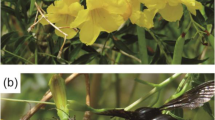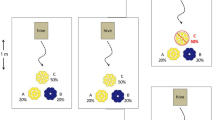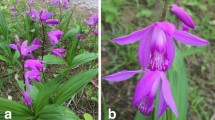Abstract
Flower visitors often fly among plants of the same species more often than is expected from plant frequency and distribution, a behavior known as flower constancy. Because of its implications for the evolution of floral traits, whether flower constancy is associated with perceptual stimuli, reward value, and/or flower handling skills has been debated by many authors. However, it remains unknown whether flower handling skill has a substantial influence on flower constancy because flowers that require different handling skills generally also differ in their appearance (i.e., shape). We investigated the foraging type constancy of Bombus terrestris workers that foraged flower patches consisting of two (Trifolium pratense and Trifolium repens) or three (T. pratense, T. repens, and Lotus corniculatus) plant species. In these flower patches, individual bees foraged T. pratense flowers by either one of the two foraging modes that require different foraging techniques (legitimate foraging versus nectar robbing). Behavioral and pollen load analysis indicated that bees sometimes switched their foraging types between legitimate visits to T. pratense and visits to T. repens and between nectar robbing on T. pratense and visits to L. corniculatus, though they rarely switched between other combinations of foraging types. These results indicate that factors other than perceptual stimuli and spatial distribution of plants affected foraging type constancy. After considering other factors, such as the rewards and the sizes of individual foragers, we argue that handling skills required to forage flowers affected flower constancy observed in this study.






Similar content being viewed by others
References
Campbell DR (1985) Pollinator sharing and seed set of Stellaria pubera: competition for pollination. Ecology 66:544–553. doi:10.2307/1940403
Chittka L, Kevan PG (2005) Flower colour as advertisement. In: Dafni A, Kevan PG, Husband BC (eds) Practical pollination biology. Enviroquest Ltd., Cambridge, pp 157–196
Chittka L, Thomson JD (1997) Sensori-motor learning and its relevance for task specialization in bumble bees. Behav Ecol Sociobiol 41:385–398. doi:10.1007/s002650050400
Chittka L, Beier W, Hertel H, Steinmann E, Menzel R (1992) Opponent colour coding is a universal strategy to evaluate the photoreceptor inputs in Hymentoptera. J Comp Physiol A 170:545–563. doi:10.1007/BF00199332
Chittka L, Thomson JD, Waser NM (1999) Flower constancy, insect psychology, and plant evolution. Naturwissenschaften 86:361–377. doi:10.1007/s001140050636
Darwin C (1876) The effects of cross and self fertilization in the vegetable kingdom. Murray, London
Dukas R (1995) Transfer and interference in bumblebee learning. Anim Behav 49:1481–1490. doi:10.1016/0003-3472(95)90069-1
Dyer AG (2006) Discrimination of flower colours in natural settings by the bumblebee species Bombus terrestris (Hymenoptera: Apidae). Entomol Gener 28:257–268. doi:10.1127/entom.gen/28/2006/257
Dyer AG, Chittka L (2004) Biological significance of distinguishing between similar colours in spectrally variable illumination: bumblebees (Bombus terrestris) as a case study. J Comp Physiol A 190:105–114. doi:10.1007/s00359-003-0475-2
Gegear RJ, Laverty TM (1995) Effect of flower complexity on relearning flower-handling skills in bumblebees. Can J Zool 73:2052–2058. doi:10.1139/z95-241
Gegear RJ, Laverty TM (2005) Flower constancy in bumblebees: a test of the trait variability hypothesis. Anim Behav 69:939–949. doi:10.1016/j.anbehav.2004.06.029
Gegear RJ, Thomson JD (2004) Does the flower constancy of bumble bees reflect foraging economics? Ethology 110:793–805. doi:10.1111/j.1439-0310.2004.01010.x
Goulson D (2000) Are insects flower constant because they use search images to find flowers? Oikos 88:547–552. doi:10.1034/j.1600-0706.2000.880311.x
Goulson D, Wright NP (1998) Flower constancy in the hoverflies Episyrphus balteatus (Degeer) and Syrphus ribesii (L.) (Syrphidae). Behav Ecol 9:213–219. doi:10.1093/beheco/9.3.213
Grüter C, Ratnieks FLW (2011) Flower constancy in insect pollinators: adaptive foraging behavior or cognitive limitation? Commun Integr Biol 4:633–636. doi:10.4161/cib.4.6.16972
Grüter C, Moore H, Firmin N, Helanterä H, Ratnieks FLW (2011) Flower constancy in honey bee workers (Apis mellifera) depends on ecologically realistic rewards. J Exp Biol 214:1397–1402. doi:10.1242/jeb.050583
Heinrich B (1976) The foraging specializations of individual bumblebees. Ecol Monogr 46:105–128
Heinrich B (1979) “Majoring” and “minoring” by foraging bumblebees, Bombus vagans: an experimental analysis. Ecology 60:245–255. doi:10.2307/1942246
Hill PSM, Wells PH, Wells H (1997) Spontaneous flower constancy and learning in honey bees as a function of colour. Anim Behav 54:615–627. doi:10.1006/anbe.1996.0467
Inoue MN, Yokoyama J, Washitani I (2008) Displacement of Japanese native bumblebees by the recently introduced Bombus terrestris (L.) (Hymenoptera: Apidae). J Insect Conserv 12:135–146. doi:10.1007/s10841-007-9071
Ishii HS (2005) Analysis of bumblebee visitation sequence within single bouts: implication of overstrike effect on short-term memory. Behav Ecol Sociobiol 57:599–610. doi:10.1007/s00265-004-0889-z
Ishii HS (2006) Floral display size influences subsequent plant choice by bumble bees. Funct Ecol 20:233–238. doi:10.1111/j.1365-2435.2006.01106.x
Ishii HS (2013) Community-dependent foraging habits of flower visitors: cascading indirect interactions among five bumble bee species. Ecol Res 28:603–613. doi:10.1007/s11284-013-1051-z
Ishii HS, Masuda H (2014) Effect of flower visual angle on flower constancy: a test of the search image hypothesis. Behav Ecol 25:933–944. doi:10.1093/beheco/aru071
Ishii HS, Kadoya T, Kikuchi R, Suda SI, Washitani I (2008) Habitat and flower resource partitioning by an exotic and three native bumble bees in central Hokkaido, Japan. Biol Conserv 141:2597–2607. doi:10.1016/j.biocon.2008.07.029
Johnson RA (1986) Intraspecific resource partitioning in the bumble bees Bombus ternarius and B. pennsylvanicus. Ecology 67:133–138. doi:10.2307/1938511
Jones KN (2001) Pollinator-mediated assortative mating: cause and consequences. In: Chittka L, Thomson JD (eds) Cognitive ecology of pollination. Cambridge University Press, Cambridge, pp 259–273
Kadoya EZ, Ishii HS (2015) Host manipulation of bumble bee queens by Sphaerularia nematodes indirectly affects foraging of non-host workers. Ecology 96:1361–1370. doi:10.1890/14-0036.1
Kearns CA, Inouye DW (1993) Techniques for pollination biologists. University Press of Colorado, USA
Laverty TM (1994) Costs to foraging bumble bees of switching plant species. Can J Zool 72:43–47. doi:10.1139/z94-007
Lewis AC (1986) Memory constraints and flower choice in Pieris rapae. Science 232:863–865. doi:10.1126/science.232.4752.863
Matsumura C, Yokoyama J, Washitani I (2004) Invasion status and potential ecological impacts of an invasive alien bumblebee, Bombus terrestris L. (Hymenoptera: Apidae) naturalized in southern Hokkaido, Japan. Glob Environ Res 8:51–66
Menzel R (2001) Behavioral and neural mechanisms of learning and memory as determinants of flower constancy. In: Chittka L, Thomson JD (eds) Cognitive ecology of pollination. Cambridge University Press, Cambridge, pp 106–126
Peat J, Tucker J, Goulson D (2005) Does intraspecific size variation in bumblebees allow colonies to efficiently exploit different flowers? Ecol Entomol 30:176–181. doi:10.1111/j.0307-6946.2005.00676.x
Peitsch D, Fietz A, Hertel H, de Souza J, Ventura DF, Menzel R (1992) The spectral input systems of hymenopteran insects and their receptor-based colour vision. J Comp Physiol A 170:23–40. doi:10.1007/BF00190398
R Development Core Team (2014) R: a language and environment for statistical computing. R Foundation for Statistical Computing, Vienna. http://www.R-project.org
Raine NE, Chittka L (2007a) Flower constancy and memory dynamics in bumblebees (Hymenoptera: Apidae: Bombus). Entomol Gener 29:179–199
Raine NE, Chittka L (2007b) Pollen foraging: learning a complex motor skill by bumblebees (Bombus terrestris). Naturwissenschaften 94:459–464. doi:10.1007/s00114-006-0184-0
Sokal RR, Rohlf FJ (1995) Biometry: the principles and practice of statistics in biological research, 3rd edn. Freeman, New York
Waser NM (1978) Interspecific pollen transfer and competition between co-occurring plant species. Oecologia 36:223–236. doi:10.1007/BF00349811
Waser NM (1986) Flower constancy: definition, cause, and measurement. Am Nat 127:593–603
Wilson P, Stine M (1996) Floral constancy in bumble bees: handling efficiency or perceptual conditioning? Oecologia 106:493–499. doi:10.1007/BF00329707
Acknowledgments
We are grateful to A. Yanagisawa, H. Masuda, H. Suzuki, and K.Y. Shinjo for their assistance in the fieldwork and to A. Ushimaru for insightful discussions about this study. We also thank anonymous reviewers for useful comments on the manuscript. This study was partly supported by a grant-in-aid for young scientists from the Japan Society for the Promotion of Science to H.S.I. (no. 20770013). All procedures performed in studies involving animals were in accordance with the ethical standards of the institution or practice at which the studies were conducted.
Author information
Authors and Affiliations
Corresponding author
Additional information
Communicated by M. Giurfa
Significance statement
We addressed the classical but unsolved question that whether handling skills required to forage flowers affect temporal flower specialization by individual pollinators. The main problem for testing the effect was that flowers that require different handling skills generally also differ in their appearance (i.e., shape). Our study reports that foraging mode by bumble bees on Trifolium pratense flower (legitimate visits versus nectar robbing by biting a hole in the corolla tube) affects foraging fidelity to that flower species in contrast to co-flowering plant species (T. repens and Lotus corniculatus). The findings suggest that not only perceptual stimuli and reward values but also the handling skills required to forage flowers could affect flower specialization by individual bumble bees.
Electronic supplementary material
Below is the link to the electronic supplementary material.
ESM 1
(DOCX 842 kb)
Rights and permissions
About this article
Cite this article
Ishii, H.S., Kadoya, E.Z. Legitimate visitors and nectar robbers on Trifolium pratense showed contrasting flower fidelity versus co-flowering plant species: could motor learning be a major determinant of flower constancy by bumble bees?. Behav Ecol Sociobiol 70, 377–386 (2016). https://doi.org/10.1007/s00265-016-2057-7
Received:
Revised:
Accepted:
Published:
Issue Date:
DOI: https://doi.org/10.1007/s00265-016-2057-7




